If you’ve started making your own pizza dough from scratch, chances are you’ve come across terms like dough starter, indirect dough, preferment, biga, and poolish. And you’ve probably been left unsure what any of it means or how to apply it to your baking. We know that the terminology surrounding poolish and dough starters can be bewildering, and it can put people off trying it. But the end results are definitely worth it, so we’ve put together this article to make things a little easier to understand and help you get started.
This is our complete guide to poolish pizza dough. We’ll tell you what it is, how to make it, how to use it, and why you would want to. And we’ll talk about some of the other dough starters too, for comparison. If you get confused by any of the terms used, don’t panic, head to the glossary at the bottom of the article for a simple explanation.
Let’s get started.
What Is Poolish?
Poolish is a highly liquid dough used as a starter or a preferment in baking bread and pizzas. It’s especially popular with bakers of Neapolitan-style pizzas as it creates delicious, light, airy and complexly flavored crust.

What Is A Starter?
A starter or preferment is a portion of yeast cultured dough that is made several hours earlier than the main bread or pizza dough. This preferment is allowed to develop for a set number of hours before being added to the main dough to improve the flavor and texture of the final bake.
There are several different types of starter and preferment – including poolish, biga, and the most commonly known one, sourdough starter. The various names and terminology can get confusing, but they are essentially all versions of the same thing – a dough made of flour, water, and yeast. And the differences come from the ratio of ingredients and the type of yeast used.
Is Poolish The Same As Sourdough Starter?
Poolish is similar to sourdough starter but not the same. They both contain flour, water, and yeast, but sourdough uses natural or wild yeast, while poolish uses commercial yeast, making it a more reliable preferment than sourdough.
They both impart an added flavor to their bakes, but sourdough starter – as the name might suggest – produces a more sour flavor thanks to the acids produced by the wild yeast. Sourdough is also more time-consuming. It takes a minimum of seven days to start and even longer to become established. It can then be maintained for months, sometimes years, as the baker ‘feeds’ it flour and water to keep it growing and the yeast cultivating over time. In contrast, poolish tends to be a one-off product, made and used as and when you need it, the process taking no longer than 24 hours.
What’s The Difference Between Poolish And Biga?
Poolish and biga are similar preferments that originated in different places. Poolish was invented in Poland and made its way through Europe to become an established method in French baking. Biga, on the other hand, is Italian in origin.
Poolish has a higher hydration level than biga. It’s made with equal parts flour and water and is a very wet dough known as a liquid preferment. It ferments faster than biga, taking between 12-24 hours to ripen. It’s known for its delicious, almost buttery taste and is a popular method for anyone baking French bread and pastries.
Biga is drier and stiffer. It’s made with a 2:1 ratio of flour to water and feels more like traditional dough. It can take up to 48 hours to ferment, has a slightly more sour flavor than poolish, and is a popular choice for Italian bread such as ciabatta and focaccia.
When it comes to baking pizzas, both biga and poolish give excellent results, and the choice comes down to your personal preference. Try them both, see which one you enjoy working with and which flavor and texture you prefer.
Why Use A Poolish To Make Pizza Dough?
It’s not necessary to use a poolish or any kind of starter when making bread or pizza. You could simply make a direct dough, adding all the ingredients in one go, which is a quicker and simpler method. However, creating an indirect dough by using a preferment or starter will give your dough a greater depth of flavor, a more complex aroma, and a better texture.
Pizza bakers especially favor it because it results in a delicious crust with a lighter texture that is more digestible to people who are sensitive to gluten. Breads made with preferments also tend to have a better shelf life than those without.
How To Make Poolish Pizza Dough
Making poolish is a simple enough process. It is a 100% hydrated dough, which means it is always equal parts flour and water plus a small amount of commercial yeast.
Gently mix the flour, water, and yeast together until the consistency is smooth, then cover and leave to ferment at room temperature for 2 hours before placing in the refrigerator to cold ferment for another 18-24 hours.
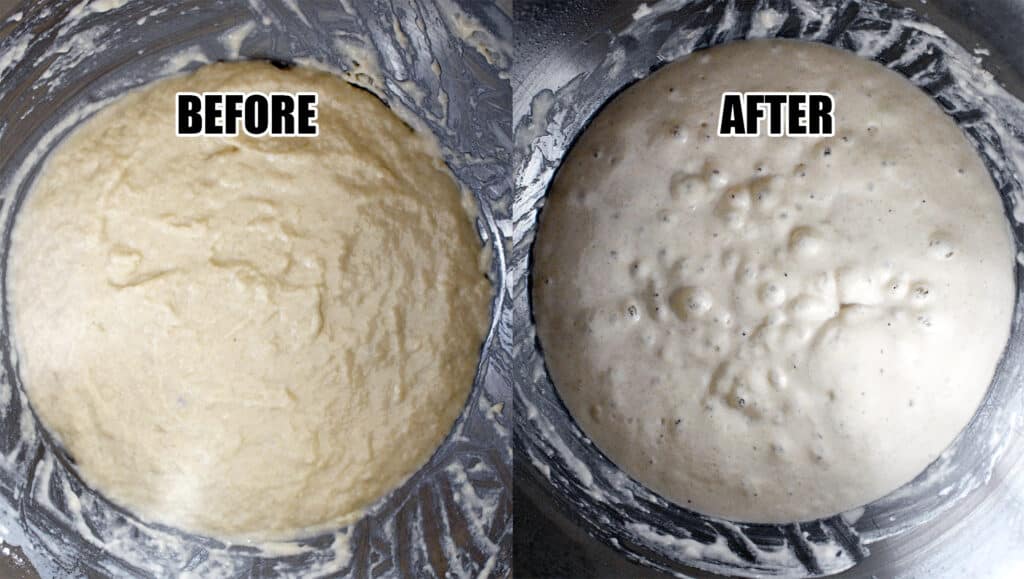
The next day, allow the poolish to come to room temperature. Then mix the ingredients for the main dough and add the poolish, folding the two together gently but thoroughly. Cover and leave to rest for 15 – 20 minutes.
Work the dough using your favorite kneading method for several minutes, then rest for 15 minutes. Repeat this process a second time.
Knead briefly once more – at this point, your dough should be smooth and stretchy. Cover with a damp cloth and leave to rise for 1 hour.
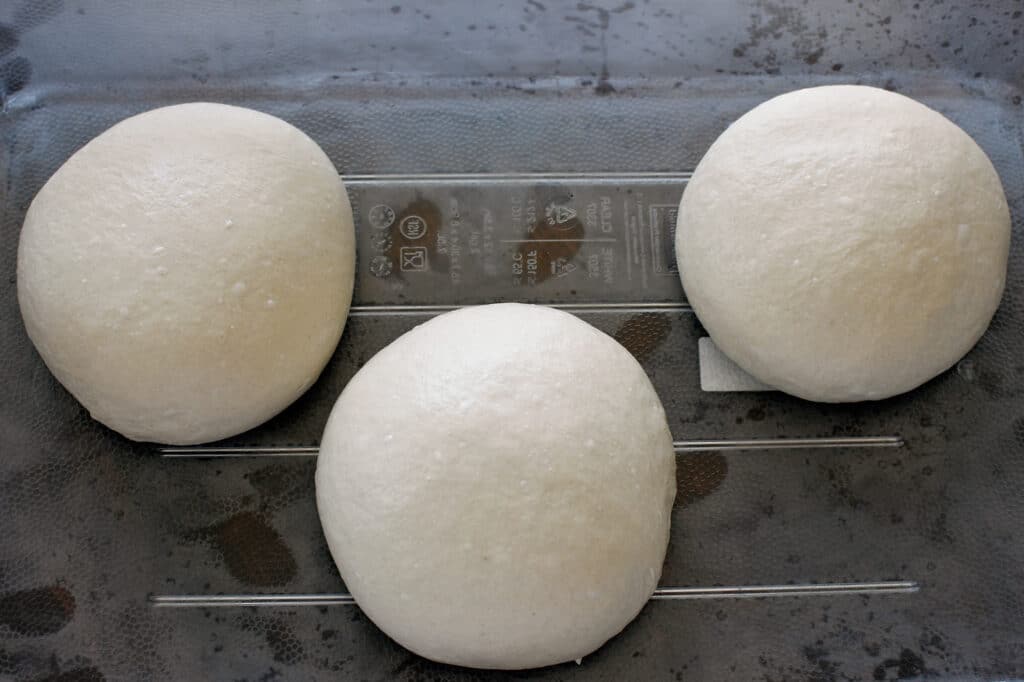
Separate your dough into balls, lay them on a tray, and cover. You can leave them to rise at room temperature for 1-2 hours and then use them. But you’ll achieve a better flavor if you place them in the fridge and allow them to cold ferment overnight.
The next day, remove your dough from the fridge, allow it to return to room temperature, then stretch, shape, cook, and enjoy!
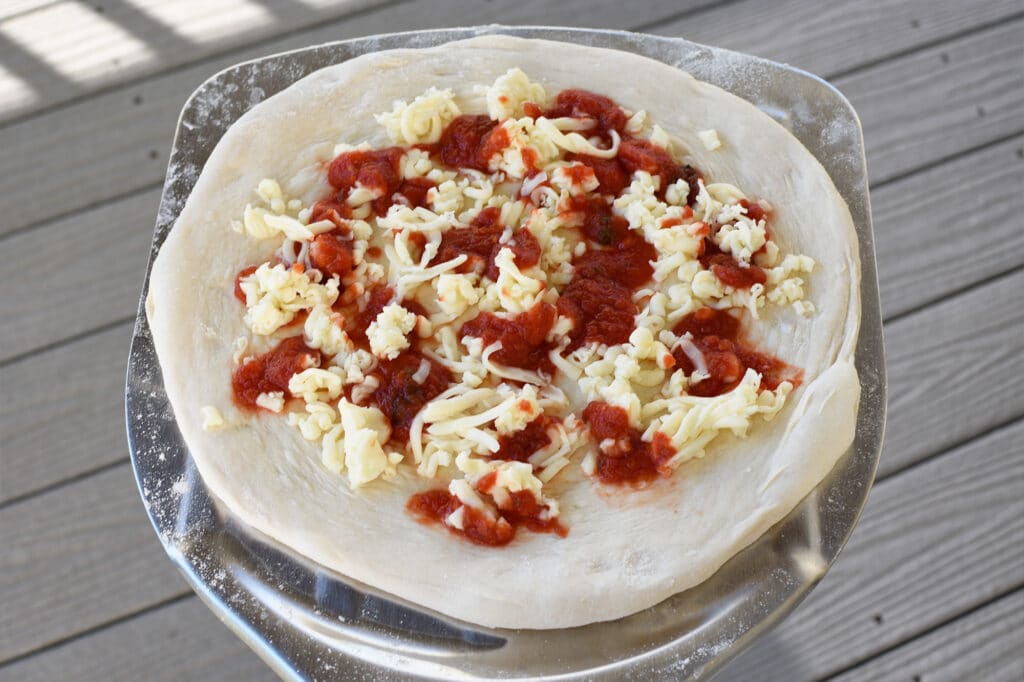
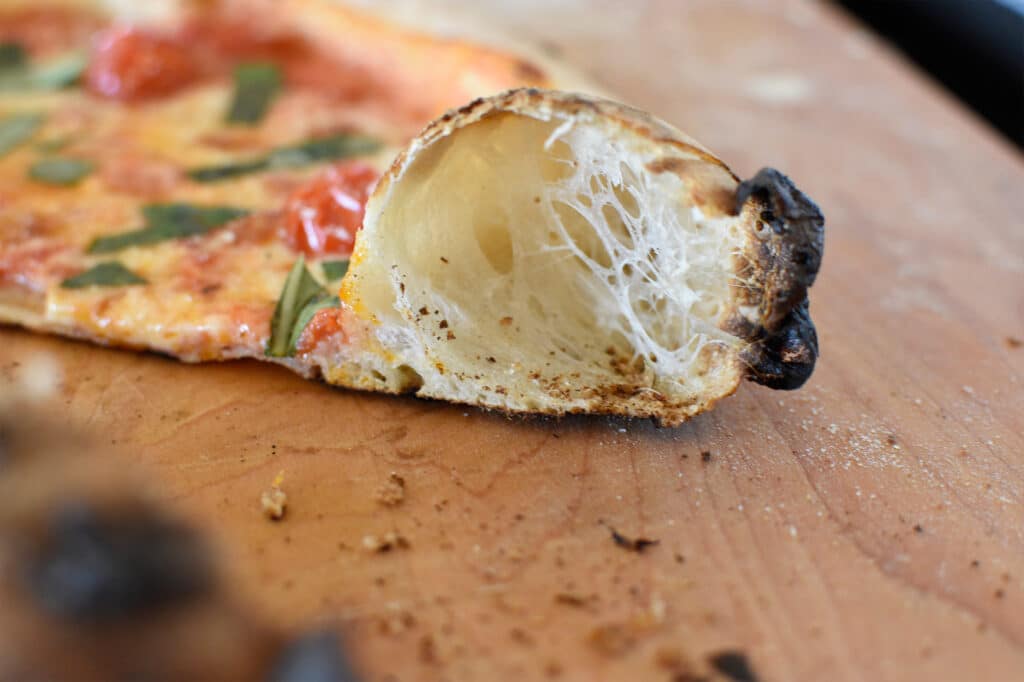
Top Tips For Excellent Poolish Pizza Dough
The poolish is ready when spongy and wet, with a domed surface covered with small air bubbles that look active and almost alive. If it has begun to sink back into itself, it has over-ripened, and you should start again.
The exact quantities of your poolish and pizza dough will depend on the recipe you’re using, but a poolish should make up roughly ⅓ of your total dough and never exceed 50%.
So if your total recipe calls for 1000g of flour, you would make your poolish with around 330g of flour and 330g of water.
The hydration levels of your dough affect the outcome of your bread or pizza. The more hydrated the dough, the lighter and airier your bake will be, but the more challenging the dough will be to work with. For beginners, we recommend starting with 70% hydration. Since poolish is such a wet dough with 100% hydration, you would use less water in the main dough mix to ensure the result is 70% hydration.
During the pizza dough fermentation process, the gluten in the dough is broken down. Since poolish is fermented for longer than direct pizza dough, the gluten is broken down further than usual. Therefore, some bakers like to use bread flour, which has a higher gluten content, for the poolish dough, and then regular pizza flour for the main dough. This lets your pizza keep a great structure while still being light and delicious.
Glossary
Starter or preferment is a portion of yeast-cultured dough that is made before the main bread or pizza dough. It is allowed to develop before being added to the main dough and results in a more complex flavor, better texture, longer shelf life, and more easily digestible bake.
Poolish is a preferment invented in Poland and common in Neapolitan pizzas and french baking.
Biga is a preferment of Italian origin. A drier version of a poolish, common in pizzas and Italian breads.
Sourdough starter is a preferment that uses wild or natural yeast rather than commercial yeast.
Commercial yeast is a strain of yeast that has been selected for its excellent ability to make bread rise and has been cultivated and mass-produced for that purpose. You can buy it easily and cheaply in most supermarkets and add it to your baking in specific measured amounts.
Natural or wild yeast occurs naturally and is found almost everywhere. When making a sourdough starter, most of the yeast will come from the flour, but some will also come from the water, air, equipment used, and even the hands of the baker who makes it. For this reason, it is unique to its environment, and bread made from it will have a unique flavor and aroma depending on where the yeast was ‘caught’.
Hydration refers to the ratio of water to flour in any dough. For example, if your dough has 100 grams of flour and 70 grams of water, the dough has 70% hydration. Poolish is a highly fluid dough with equal parts water to flour, so 100% hydration.
Direct dough is the name given to doughs that are made all at once. It is the simplest and quickest method of dough making as all the ingredients are mixed together at one time. Our awesome New York Style dough and 24 hour cold ferment Neapolitan dough are both considered direct doughs.
Indirect dough is the term for doughs that involve starters or preferments. They are made in two stages. The preferment is made first and then added to the main dough later. It’s a lengthier process but results in more delicious breads and pizzas.
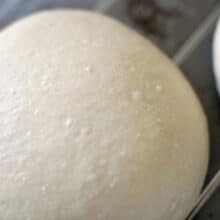
Easy Poolish Pizza Dough
Equipment
- Outdoor pizza oven – You'll need high heat for this recipe. Check out this link for my in-depth review of over 30 pizza ovens I personally tested.
Ingredients
**NEW DOUGH CALCULATOR**
- Poolish dough calculator Easiest way to customize pizza size, quantity, and hydration. The calculator uses this recipe when toggling the "poolish" option.
Preferment (poolish)
- 175 g 00 flour Caputo "Pizzeria" is the ideal choice.
- 175 g Water Lukewarm (80-90F) to jumpstart the yeast.
- 3 g Honey Or about 1/2 tsp.
- 1 g Instant Dry Yeast (IDY) This Caputo yeast (linked) is a game changer and makes a world of difference. It's labeled as Active Dry Yeast, but acts as IDY (mixes directly into flour – no activating)
Final Dough
- 325 g 00 flour
- 125 g Water Lukewarm (80-90F)
- 12 g Salt
Instructions
Poolish (Day 1)
- In a glass measuring cup or microwavable bowl, heat water in the microwave for 20 seconds; this should result in a temperature of 80-90F.
- If you're using Fresh or Active Dry Yeast, mix the yeast into the water and let sit for 2 minutes. If you're using Instant Dry Yeast (IDY), proceed to the next step. Note: Caputo yeast is labeled as Active yeast, but does not need to be activated in water (works as IDY).
- Add the flour (preferment section only!) and IDY yeast to the bowl of a stand mixer. Next, add the water (preferment section only!) and mix well with hands, or a spoon, until fully incorporated.
- Cover with a lid or saran wrap, tightly. Allow to sit at room temperature for 2 hours before placing in the refrigerator for 18-24 hours.
Dough (Day 2)
- Remove poolish from refrigerator and allow to come to room temperature, about 1 hour. With the poolish still in the bowl of a stand mixer, add the remaining water (final dough section!) and mix by hand. Fit the mixer with a dough hook and turn on medium. Slowly add flour (final dough section!) and salt and mix until dough is smooth and elastic, scraping down the flour on the sides with a spatula as needed, 5-8 minutes.
- Remove dough from bowl and knead by hand, 2 minutes. Flip the bowl over top of the dough and allow to rest for 20 minutes; you will notice the gluten is stronger after the rest. Divide the dough into equal pieces, roughly 270g each. Knead into a taut ball before placing in a lightly oiled bowl or proofing container, seam-side down. Cover the bowl with a lid or saran wrap and place in the refrigerator to cold ferment for another 18-24 hours.
Pizza Day (Day 3)
- Remove the dough from the refrigerator and allow to come to room temperature, at least 2 hours (assuming 70F; +/- an hour depending on room temp). With a lightly floured dough scraper/cutter, gently pick up a doughball and place it into a bowl with 50/50 semolina and 00 flour. Lightly coat both sides to prevent stickiness before continuing to stretch and bake.



